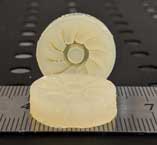
Scientists from the Macromolecules Innovation Institute (MII), the College of Science, and the College of Engineering at Virginia Tech have overcome some long-standing limitations of 3D printing by developing a new custom 3D printer with an embedded computer vision system. The system can process and print high-resolution features of liquid latexes and other unprecedented materials, including rigid plastics.
Usually, high molecular weight polymers such as liquid latexes are not amenable to vat photopolymerisation (VP) additive manufacturing (3D printing) due to high solution and melt viscosities. VP is a process whereby the printer uses UV light to cure, or harden, a viscous resin into a specific shape.
However, for effective printing, the printer must be capable of printing high-resolution features across a large area and finally, in 2017, a custom printer was designed that could do just that.
The printer is additionally embedded with a camera to capture an image of each vat of latex resin. With his custom algorithm, the machine is able to “see” the UV light’s interaction on the resin surface and then automatically adjust the printing parameters to correct for resin scattering outside of the projected UV light on the latex resin surface and will cure just the intended shape.
“This project represents the quintessential example of interdisciplinary research,” said Timothy Long, a professor of chemistry and a co-principal investigator on this project along with Christopher Williams, the L.S. Randolph Professor of mechanical engineering and interim director of MII. Both have credited their counterpart’s expertise for making the collective breakthrough possible.
